Still: Amy Adler
by Jordan Karney Chaim
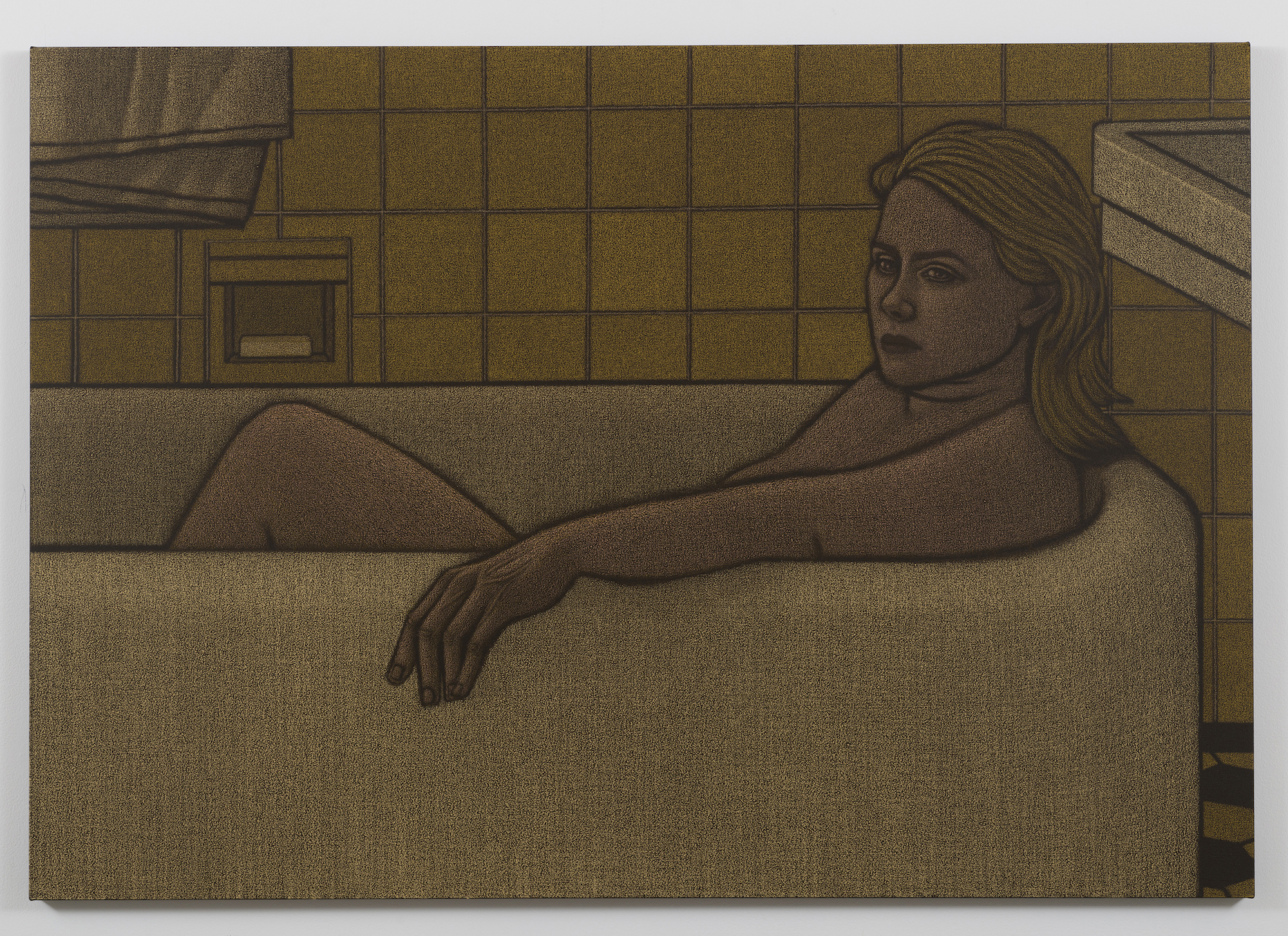
Amy Adler, Hotel, 2018, series of 6 oil pastel on canvas, 56 inches x 80 inches each. Courtesy of the artist.
In 2018, Amy Adler presented her most recent body of work, Hotel, at Vielmetter Los Angeles. Each of the series’ six monumental oil pastel drawings on canvas depicts Adler alone in a hotel room. She stares out from the bathtub or at her reflection in the mirror. She sits on the edge of the bed or in an upholstered chair, never meeting the viewer’s gaze. She is pensive if not melancholic, distracted, possibly exhausted. She is nude or wrapped in a towel, and while the images are revealing, the visual softening produced by pastel on the weave of the canvas reduces the sense of exposure. The series is executed in a limited palette of beiges, yellows, and browns, lending the images a sepia tone that, along with their generic hotel surroundings and lack of geographical and temporal markers, enhances their unplaceable quality. Adler’s images are based on photographs taken of her in various hotel rooms over the preceding ten years. It’s not clear whether she or someone else is the photographer; the degree of their staging, of Adler’s performance for the camera, is also ambiguous.
What is palpable across the series is narrative tension, despite the relative spareness of the scenes and their solitary subject. Hotel, like much of Adler’s work, is deliberately cinematic; we know we’ve entered a story, but it’s not clear at which point. What has just transpired? Or what is about to transpire?1We are given access to an intimate moment, but the strength of Adler’s narrative pull precludes purely voyeuristic consumption; the image attracts our attention, but it is all that is withheld that sustains it.
Since the 1990s Adler has used film stills and photographs (her own as well as found) as the basis for her work, methodically drawing the existing images, most often in pastel. In the careful construction of her compositions, she stages scenes that buzz with a dynamic charge, even when depicting only a single figure. The ambiguity of her narratives is intentional; as she’s said, she aims for pictures that are struck by “multiple tangents,” and “belong in several storylines.”2As Adler redraws her imagery, she is able to move between and offer up multiple subject positions—to stand on both sides of the lens. Reading her pictures requires sustained attention.
The dynamic between photography and drawing in Adler’s work has shifted over the course of her career in ways that elucidate our changing relationship to photography in the 21st century. Over the last decade and a half, the typical experience of photography has become a high-volume stream of (often ephemeral) images flashing across our screens. “Shoeboxes of photos under the bed,” as photo historian Kate Palmer Albers writes, “belong to a different generation.”3Adler’s engagement with both her photographs and photographic subjects resonates with the pre-digital age, when photographs were commonly experienced as physical printed objects, subject to a kind of ritualized looking.
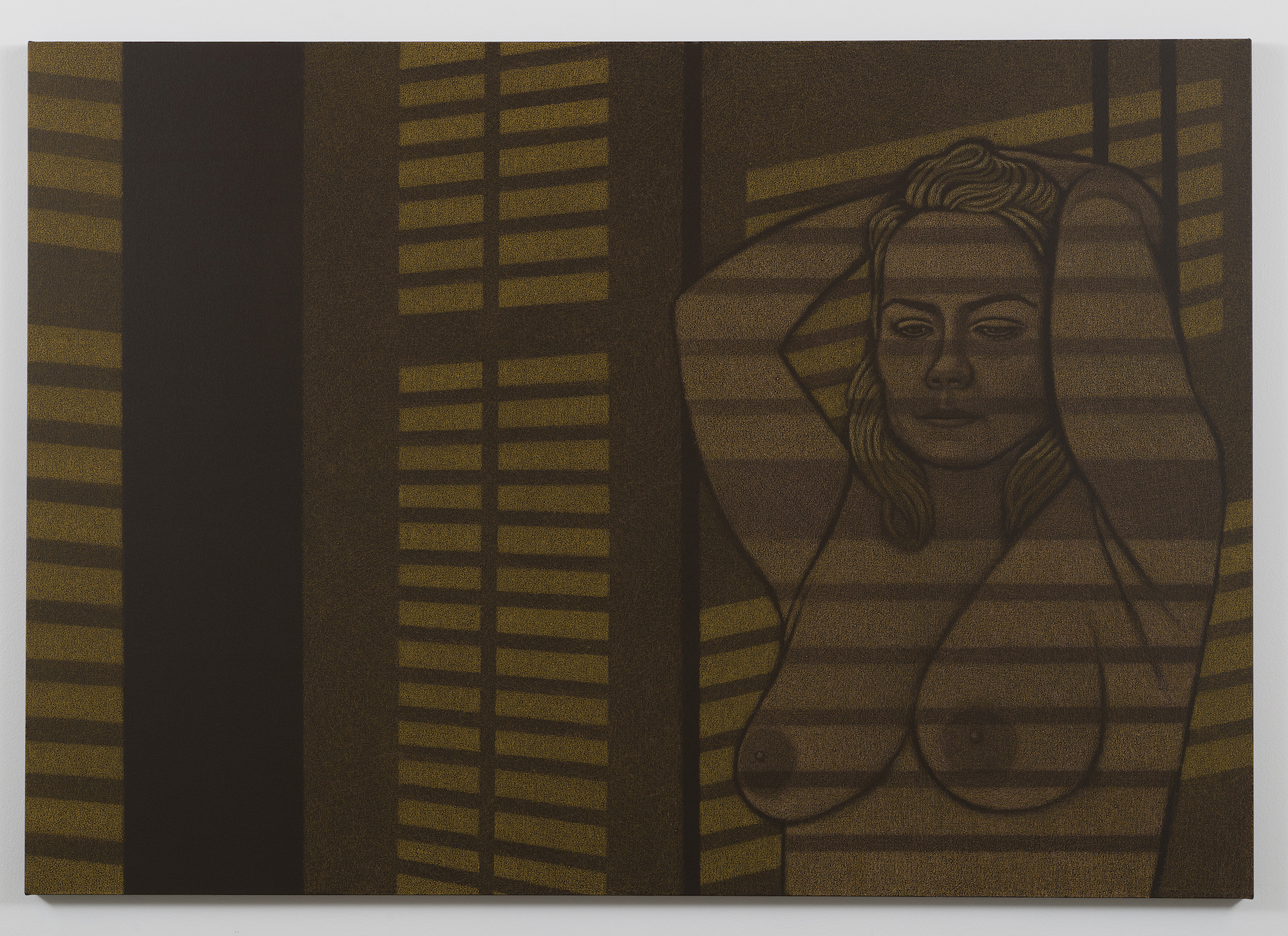
Amy Adler, Hotel, 2018, series of 6 oil pastel on canvas, 56 inches x 80 inches each. Courtesy of the artist.
Adler graduated with her MFA from UCLA in 1995, amidst a surge of attention directed at Los Angeles’s “unusually good” art schools.4 In the absence of a strong museum and gallery scene during the 1970s and ‘80s, area art schools became essential hubs of creative exchange. UCLA, in the late ‘70s, began to “shed its mid-century origins,” as art historian John Tain writes, adding Chris Burden to its faculty in 1978, followed by Charles Ray in 1981, and Nancy Rubins and Paul McCarthy in 1982. By the nineties their faculty and recent graduates were attracting unprecedented critical interest.5 Stories of the “L.A. MFA as a red-hot commodity,” began to appear in the national press from Artforum to The New York Times to Vogue.6A 1997 article by longtime Los Angeles writer and artist Dennis Cooper pronounced that if “UCLA were a rock scene, it would be Seattle right after [Nirvana’s] Nevermind went platinum.”7 As a graduate student Adler worked most closely with Ray, Lari Pittman, Catherine Opie, and Lutz Bacher, and was part of a cohort of students and recent graduates that included Kevin Appel, Kurt Kauper, Toba Khedoori, Monica Majoli, Jennifer Pastor, and Jason Rhodes. The lure was so powerful that it became somewhat common for dealers to frequent art students’ studios, offering them shows before they had finished their degrees.8
The process Adler developed during the nineties—making a drawing based on photographic sources, photographing the drawing, destroying the drawing, and exhibiting a unique photograph—became the focus of much critical attention, often placing her in dialogue with Pictures Generation affiliates such as Sherrie Levine, Richard Prince, and Cindy Sherman.9Adler’s acts of appropriation, however, have less to do with the death of the author than reclamation of subjects and subjectivity as a queer woman. “As Adler has learned from Levine,” writes Liz Kotz, “the act of remaking the image makes it ‘her image,’ and explicitly implicates her within this circulation of desire and cultural myths…”10 The lens of desire in Adler’s work, as the artist described it, is often that of a “girl-looking-at-girls.”11 It is through the physical translation process of photograph to drawing, which is often quite laborious, that Adler renegotiates vulnerability, desire, and power dynamics from a queer feminist perspective.12
Between 1995 and 2002, Adler’s layered process (described above) began and ended with a photograph.13 She worked from photos in her possession, including photos taken of her by others, or images lifted from magazines, newspapers, advertisements, and album covers. Before the internet made the last hundred years of pop culture instantly accessible online, such ephemera often ended up alongside personal photographs on bedroom walls, in albums, and in shoeboxes under the bed. The physical photos we selected and saved before the advent of digital photography resulted in a particular kind of autobiographical archive, a curated selection of memory and desire that often combined records of the real with the aspirational.14 The act of possessing these images offered a means of connection to their subjects. Photography critic Vince Alleti has described the significance of this notion of possession, writing: “the still image has always exerted a different sort of power for me, because a picture—in a book, in a magazine, in my hand—could be mine. To have and to hold. As they accumulated, those images began to define my life.”15 The printed photograph functions as a stand-in for the object of our desire, and when placed alongside our own personal photographs, assumes a kind of intimate familiarity as we return to it over time.16 Our relationship to the images in our possession is defined by ritualized looking: in an intentional act of sustained attention, we hold (or behold) the photographic object while recalling the past or imagining future (or alternate) realities.
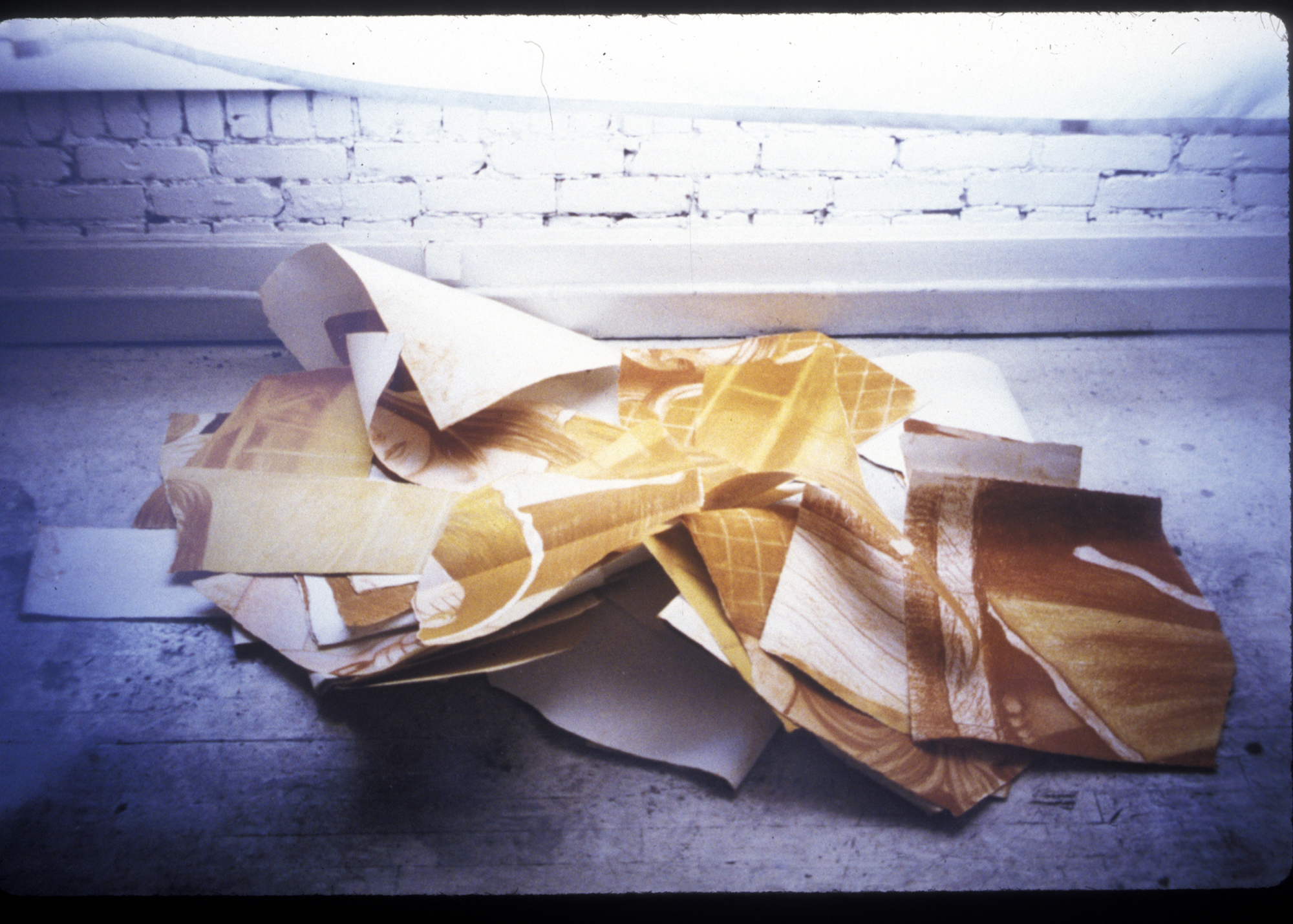
Photograph of Amy Adler, What Happened to Amy? (1996), destroyed. Courtesy of the artist.
A personal photo collection has long served as a safe space for the projection and expression of desire. Aletti describes this too, continuing:
“The first thing I did in a new dorm room or apartment was tack pictures to the wall… I wasn’t consciously queering the space, but as my rooms filled up with images of men, I realized I was queering the pictures. It didn’t matter who made them or with what intentions. Now that they were mine, they became expressions of my desire, my obsession, my imagination.”17
Queering the pictures is essential to Adler’s practice, and she explores the fluidity and complexity of desire—its production, expression, and permissibility—across male and female bodies.18 In her description of Adler’s 1994 work, Team,19 a series of drawings of young male baseball players based on photos from a sports magazine, Kotz writes that Adler’s “doubled-back process of production suggests that we are being let in on a private world of fantasy, a psychic place where many desires converge: looking and wanting, danger, displaced self-representation, evil twin, ‘I can be that boy for you.’”20When Adler exhibits her work—when she tacks her pictures to the wall—she is consciously queering the space, transferring the intimate explorations of desire linked to private photographs (and the act of drawing) to the public space of the museum or gallery.
Adler has spoken about the relationship between drawing and adolescent yearning, as another point of access to an object of desire:
“I guess I’ve always equated my drawing with…the height of your adolescent experience. I feel like most people stop drawing when they are teenagers… And it’s replaced—it’s like your virginity is embedded in your drawing. Sex is what ends [it]…like your ability to have what you want is the thing that ends this desire to draw…”21

Amy Adler, What Happened to Amy? (1996), series of 5 unique C-prints, 16 inches x 20 inches each. Courtesy of the artist.
Adler’s use of celebrity source material is a conscious exploration of the relationship between drawing, desire, and fantasy. Different Girls (2001),22a series of 12 unique cibachrome photographs, elucidates the overlapping desires to both be and be with the subject of the image. Each work depicts an individual “girl,” based on publicity images of a range of female musicians, actors, athletes, and models. Some are dressed for maximum sex appeal, some are topless, but each performs for the camera, gazing directly at the viewer with the kind of seductive non-smile that invites visual consumption, but draws the line there. As Catherine Grant points out in her discussion of these works, “here fandom becomes a way into queer desire, presenting the viewer with a series of desirable images or selves that are not fixed by a binary notion of gendered identity, or of the divide between the self and other.”23Through the process of physical translation from publicity images to drawings to unique photographs, Adler increases her proximity to these Different Girls,24while the exact nature of her (and our) relationship to them remains ambiguous.
Adler tests the mutability of her own subject position when she appears in her work, as she has intermittently since the mid-nineties, most recently in Hotel (2018). The earliest example of this is What Happened to Amy? (1996),25a suite of five images in which Adler reclaimed photographs taken of her preteen self by a stranger who approached her on the beach in Fire Island, New York. These images feature Adler seated on the beach, the boardwalk, a wagon, or a swing. She wears a tiered sundress, her long hair often partially obscuring her face. Questions of consent hang in the air. Adler’s persistent interest in standing on both sides of the lens is what drew her back to these photographs, and as she recreated them, she was able to occupy both positions. The exchange between photograph and drawing also allows Adler to consider the potential for vulnerability inherent in each medium: is she rendered more vulnerable in a photograph of herself taken by someone else, or in a drawing of her body produced by her own hand?
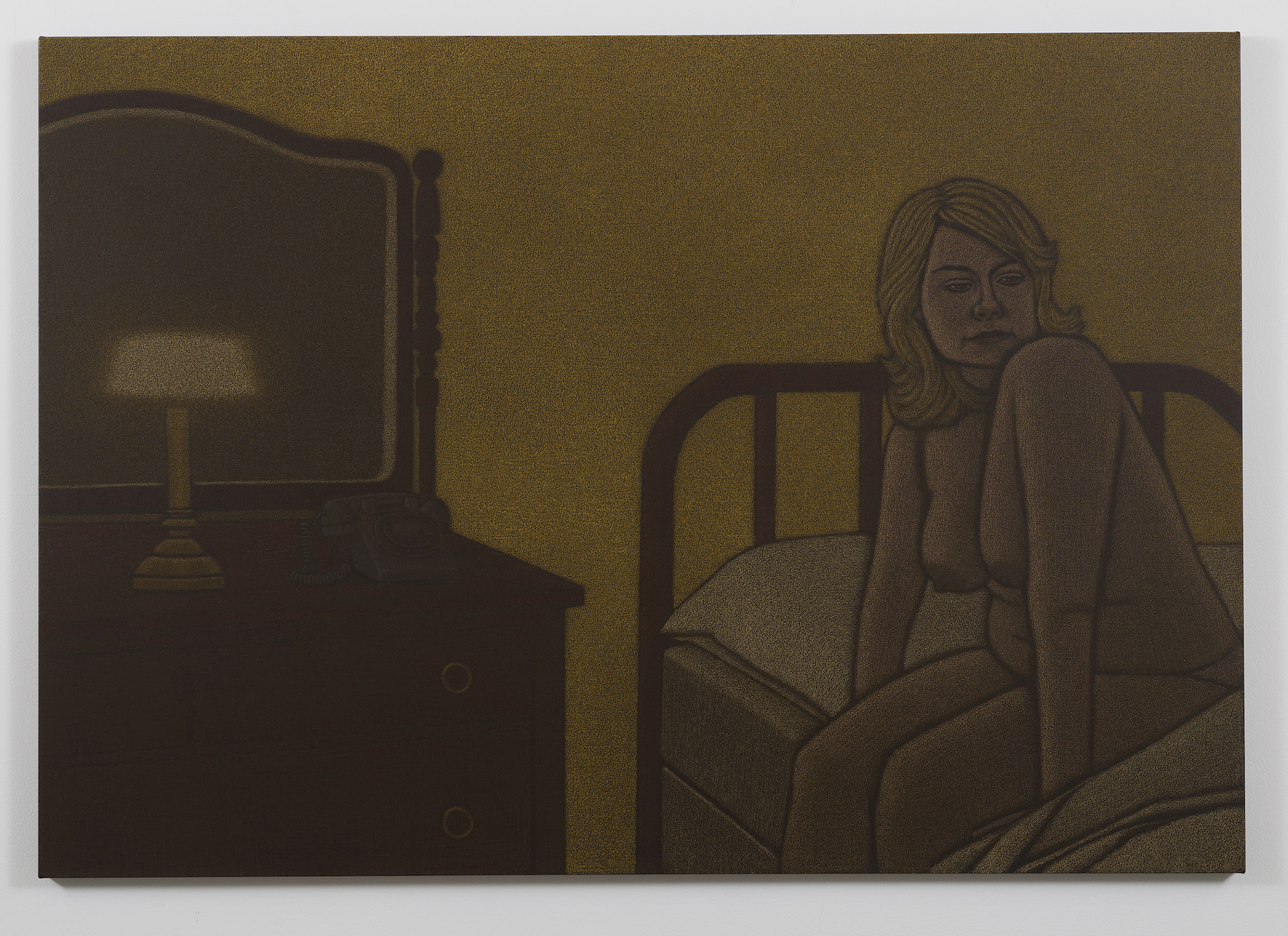
Amy Adler, Hotel, 2018, series of 6 oil pastel on canvas, 56 in. x 80 in. Courtesy of the artist.
As photographs moved from the shoebox under the bed to the internet, we became disconnected from the kind of ritual looking that drives the narrative tension at the core of Adler’s practice. The pace at which we encounter images, their (public) accessibility, and their sheer volume affect the way we derive and assign them meaning.26Once a photo enters the deluge of online images, even if some privacy is retained through settings selections, its personal significance is changed, if not diluted, by its existence within an ever-renewing photo stream. The very notion of “still” photography seems anathema to the rush of images that defines the contemporary experience of viewing photographs online.
This experiential shift has been so profound that several photo historians have theorized that the constant exchange of digital images has effectively turned photography into a new kind of speech.27Within the realms of digital photo-sharing and social media, this language has developed a kind of frivolity that reflects the ceaseless torrent of digital content.28The common experience of photography today favors a quick reaction over sustained engagement, a “like” rather than contemplative inquiry.29Adler’s work is oriented toward the latter: “I want to communicate with the person looking and be inviting,” she explained to me, “but at the same time I’m not trying to tell you something as much as I’m asking a question and inviting you into a dynamic.”30The content in Adler’s work extends beyond the visible and relies on the viewer to help flesh out its context.
In 2002 Adler stopped producing photographs. She still uses them as the basis for her projects, but now exhibits her work primarily as pastel drawings on canvas. This shift had two key drivers: concern that discussion of her process had begun to dominate the discourse surrounding her work, and a sense that new technology was beginning to change the way we looked at artwork in general, and photography in particular:
“When I started this practice and this process, it was the mid-90s and it was just at the advent of AOL, personal computers, cell phones, and Photoshop. The proliferation and pace of imagery was very different. The idea of only looking at a piece of artwork through a screen was somewhat novel, and now it’s the primary way to look at artwork, so it means something very different.”31
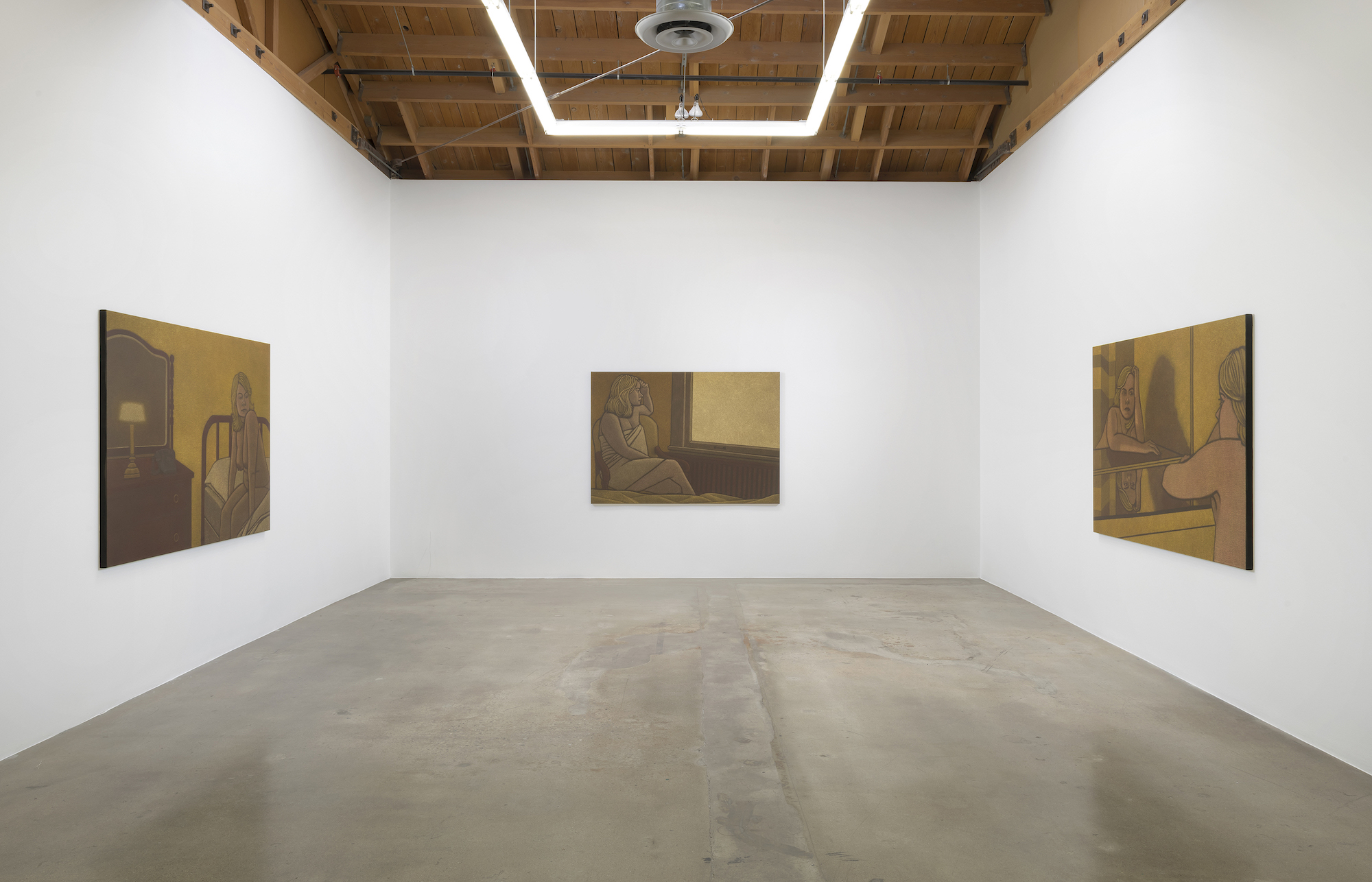
Amy Adler, Hotel, installation view, Susanne Vielmetter Gallery, Los Angeles, 2018. Courtesy of the artist.

Amy Adler, Director, installation view, Museum of Contemporary Art San Diego, 2006. Courtesy of the artist.
In altering her process Adler doubled down on her commitment to the analog experience, creating works that resist digital consumption, as much as that’s possible.32 The powerful resonance of Adler’s pictures comes from the suggested narratives they generate, narratives to which we are given only fragmentary access. This skillful distillation of story into image is rooted in Adler’s deep engagement with film, which she bolstered by returning to graduate school in 2008 to earn her MFA in Cinematic Arts at USC. “Even though I’d been using film references in my work for so many years,” she told me, “I didn’t really understand what it meant to stand on the other side of the lens and have access to the knowledge and craft of film production.”33Attaining fluency in the language of film enhanced the visual and conceptual dimensionality of Adler’s projects. Drawing has become a kind of a hinge between Adler’s filmmaking and artwork, connecting two complementary modes of storytelling. In drawing for film (storyboarding), Adler’s pictures must generate the narrative in its entirety, with enough clarity and specificity to translate into a seamless sequential story; on paper or canvas, drawing refines a storyline into a single compelling image, through a deliberately oblique process with built-in acts of denial. When she made photographs, that denial was partially bound up in the destruction of the drawing. “The drawings were withheld previously, and now they’re not” she explained, “but it’s the withholding that I was looking at all along.”34
Adler’s practice has always existed between paradigms, as she’s said.35 The monumental works that comprise Hotel are not paintings, though they are a kind of oil on canvas—they are photographic, but clearly not photographs; they are a series, but not sequential; and Adler doesn’t think of them as portraits. What she generates through the interplay between photograph, film, and drawing is perhaps best described as a still: a hand-drawn image that, in its distancing from its actual referent and its insistence on a before and after, recalls the experience of both the discrete photographic object and the film still. Adler’s persistent withholding is what preserves space for ritual looking; the search for the story is what encourages us to slow down and consider the signifiers that imbue her images with their many narrative potentialities. Her work combats the current tendency, described by photo historian Martin Lister, “to dissolve the interface, to render it invisible, to connect directly… To pursue the end of media!”36 Adler instead relies on a strategic layering of media precisely to avoid this kind of conflation, to create the space necessary for the context(s) of the picture to emerge. Immediacy is less useful when the subject matter of an image exceeds the visual.

Amy Adler, Hotel, 2018, series of 6 oil pastel on canvas, 56 inches x 80 inches. Courtesy of the artist.